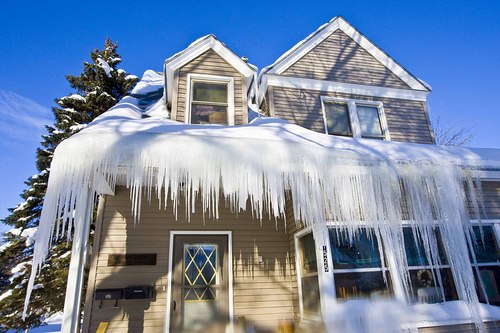No one wants to be dammed, that’s why Renovation Smart is telling you what you need to know about ice dams to prevent them. Ice dams damage gutters, destruct shingles, and result in water backing up behind fascia, into the soffits and into the home. Peeling paint, warped floors, stained and sagging ceilings are just a few of the consequences. On top of that, trapped water is susceptible to mold and mildew.
Looking to avoid potential dangers and expensive repairs caused by ice dams? The following is a collection of professional advice for real homeowners preparing for winter’s long visit.
What is an ice dam?
An ice dam is the accumulation of ice on the edge of the roof. This build-up of ice on the eaves prevents any melting snow from draining. With no place to drain, the water takes a trip below the shingles, and sometimes beneath the subdeck (plywood, planking, etc) – seeping into the soffits/walls and eventually creating damage to ceilings, insulation, and floors.
How does an ice dam form?
Simply put, an ice dam forms when the temperature of the upperlevel of your home (the attic, the underdecking of the roof) is above freezing temperature, meanwhile the outside air temperature is below freezing. The snow on the roof will melt and then refreeze once it’s rolled to the eaves, where it’s much colder. As more and more snow melts and freezes in a designated spot, an ice dam forms. In sum, the combination of freezing temperatures and a layer of snow along with heat being lost from the house results in ice dams.
What causes an ice dam?
Your roof’s temperature is influenced by a number of factors. These factors are:
Improper Insulation (either installed incorrectly or has inadequate *R-value)*
*R-value is the level of resistance the insulation carries. The higher the number, the greater its resistance against heat loss. The U.S. Department of Energy determines the minimum and maximum R-values required for building areas, by geographic location. It’s important that the attic, basement/floor, and walls follow these standards.
Gaps leaking warm air from the living area into the attic
Improper Ventilation – Proper ventilation is determined specific to your home’s structure.
Location of your home (climate, region, exposure to the sun, tree coverage, etc)
How Do I Know I Have An Ice Dam?Ice and Snow Covered House
Unruly icicles… look cool but they might mean your roof isn’t. And,
they’re dangerous.
The forming of ice behind gutters.
Ice coming in through the soffit.
Water or ice on the exterior wall.
Moisture or the formation of ice below plywood – in the attic or on the underdecking.
The appearance of water stains.
Wet, damp areas behind walls (which are not always visible).
Chances are if you’re seeing icicles, wearing an absurd number of layers in the house, or your roof is experiencing leaks, you might have an ice dam.
How Can I Prevent Ice Dams?
It’s necessary that the roof temperature be the same as its overhang. Taking measures to ensure your home is properly insulated and the attic ventilated are a great start to preventing ice dams. You can’t change the outside temperature, unless your plans involve relocating to warmer geographic areas. But you can change how warm air flows within your home.
Add insulation in the attic. Finding out exactly how much will do the job might require asking a professional. This will keep the heat in your home where it should be; in living areas. Plus, you’ll be saving on heating costs, a win-win!
Proper ventilation in the attic keeps cold air in and allows heat to dissipate. The continuous air flow will prevent the hot air from sticking around long enough to melt the snow above the roof. Having proper ventilation protects from humidity and therefore the accumulation of mold.
Seal any gaps that allow warm air to get into the attic. The attic hatch is a regular culprit. Other places to look include house fans and plumbing vents.
Winterize your home. Clearing your gutters in the Fall is one of the first steps to ice dam readiness.
Not long ago we talked about pantyhose as part of a checklist to winterize your home. If you usually have ice form in the gutter, fill a nylon stocking with ice melting tablets and place it in the gutter.
Remove the snow from your roof. Using a snow rake or shovel, clear the snow before it has time to melt and freeze. This can be dangerous, so make sure to take the right precautions or hire a professional. The bottom 3-6 feet will be enough, but clearing the entire roof is best for even weight distribution. One cubic foot of snow initially weighs 3-4 pounds. If wet, that snow can weigh up to 12 pounds per cubic foot. Think, if you could lose 12 pounds with one shovel, wouldn’t you? Letting that snow weigh over your head is nearly 32 tons of pressure.
Don’t let winter knock you down when it hits. Know these few things about ice dams and your roof and home will be safe from pricey repairs.
Want Professional Advice about your Roof?
If you have any questions about your roof, give us a call at (780)994-7887. We’ll be happy to answer all your questions and come out to inspect your roof. We are working all winter long so don’t hesitate to contact us.
Haro’s Roofing A Perfect Installation Every Time!
www.harosroofing.com
Book a FREE, In-Home Consultation

